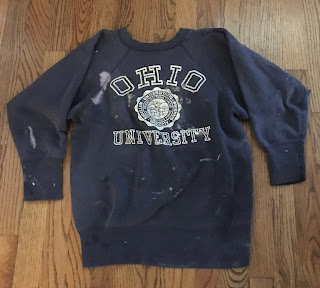Before Corona the only time I wore a sweatshirt was when I was painting. I have only one, and it holds the history of every place I've lived since 1960.
Social distancing of the extreme variety (venturing out for not more than groceries and doctors' appointments) began for us in March, when it was already getting warm in south Texas.
All summer I wore decent clothes around the house—cotton pants, knit tops or button downs. Yes, I "got dressed" later and later, but when I did they were respectable. I would not have been ashamed to see Matthew McConaughey should he have turned into the Amazon driver.
 |
| Matthew, is that you? |
Now that winter is near, the comfort of sweats is calling. Like most of us, my willpower is weaker. It's harder to choose a cute outfit to wear nowhere and easier to put on something that feels cozy. I've read about the slippery slope that are sweats. Wear them every day and you are one step from never getting dressed at all!
Remember a few years ago when dressy pajama tops were a street wear trend? I don't think you could get away with that today.
Women were running towards athleisure before the pandemic. There was a fuss at first, then even high-end designers put out athleisure wear collections. I never joined in because the last thing I've ever wanted to do was spend big money on gym clothes. Target has served me very well, thank you. AND I only wore them to the gym (with maybe a stop for a quart of milk).
 |
| Once gym clothes were cuter... |
Sweats are not even gym clothes. You wouldn't want to work out in them because, well, you would sweat. Sweats are for...being around the house in a pandemic.
If the pandemic has taught us anything it's that we want to be comfortable. I think we will have less tolerance for the ties that bind and chafe and pull. It will be hard going back to structured suits and heels just because they are expected, although that will be a small price to pay for freedom of movement in the world.
 |
| Worth it |














